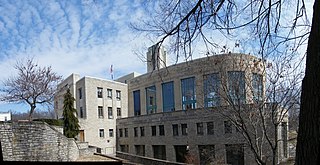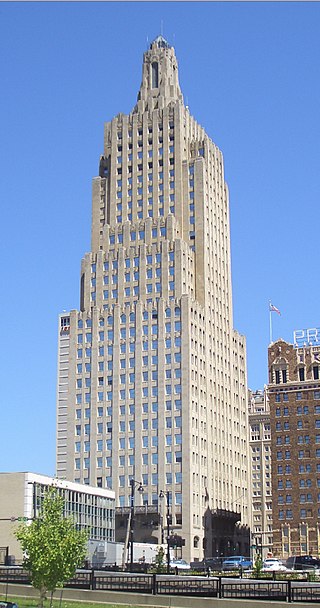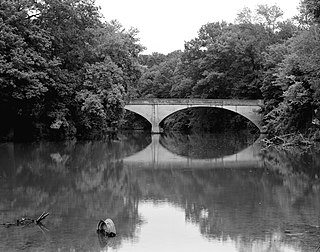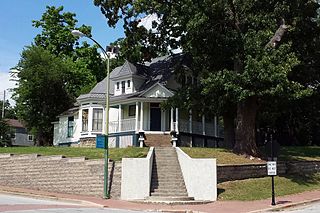
Siloam Springs is a city in Benton County, Arkansas, United States, and located on the western edge of the Northwest Arkansas metropolitan area. As of the 2020 census, the population of the city was 17,287. The community was founded in 1882 and was characterized by the purported healing powers of the spring water feeding Sager Creek and trading with nearby Native American tribes. The city shares a border on the Arkansas–Oklahoma state line with the city of West Siloam Springs, Oklahoma, which is within the Cherokee Nation territory. It is home of John Brown University.

Excelsior Springs is a city in Clay and Ray counties in the U.S. state of Missouri and part of the Kansas City metropolitan area. The population was 10,553 at the 2020 census. It is located approximately 30 miles (48 km) northeast of central Kansas City, Missouri.

John Brown University (JBU) is a private, interdenominational, Christian university in Siloam Springs, Arkansas. Founded in 1919, JBU enrolls 2,343 students from 33 states and 45 countries in its traditional undergraduate, graduate, online, and concurrent education programs.
KFPW is a radio station broadcasting a talk radio format to the Fort Smith, Arkansas, area. The station is licensed to Pharis Broadcasting, Inc which is owned by William L. Pharis and Karen A. Pharis.

Hoit, Price & Barnes was a prominent Kansas City architectural firm in the early 20th century. It designed several skyscrapers and mansions including three of the current ten tallest buildings in Kansas City; the Kansas City Power and Light Building, 909 Walnut, and Oak Tower.
Brown House may refer to:

Boggsville is an extinct town located in Bent County, Colorado, United States. The town was located near the Purgatoire River about 3 miles (4.8 km) above the Purgatoire's confluence with the Arkansas River. It was established in 1866. The surviving structures are among the earliest examples of Territorial architecture in Colorado. Boggsville was the last home of frontiersman Kit Carson before his death in 1868 at Fort Lyon. The U.S. Post Office at Las Animas now serves Boggsville postal addresses.
The University of Arkansas Campus Historic District is a historic district that was listed on the National Register of Historic Places on September 23, 2009. The district covers the historic core of the University of Arkansas campus, including 25 buildings.

The Illinois River Bridge, also known as the Midway Bridge, is a historic concrete arch bridge near Siloam Springs, Arkansas. It is located in Ozark National Forest, about 6 miles (9.7 km) east of Siloam Springs, at the end of Chambers Springs Road south of United States Route 412. The bridge has two elliptical arch spans, each spanning 68 feet (21 m), with a total structure length of 139 feet (42 m). Built in 1922 by the Luten Bridge Company of Knoxville, Tennessee, it is one of a modest number of bridges of this once-popular and common type remaining in the state.

The Bratt-Smiley House is a historic house at University Street and Broadway in Siloam Springs, Arkansas.

The Camp Crowder Gymnasium is a historic school building at 205 Shiloh Drive in Sulphur Springs, Benton County, Arkansas. It is primarily a building with local significance, and also is a rare example of military construction in the small community.

The Connelly-Harrington House is a historic house at 115 East University Street in Siloam Springs, Arkansas.

The First National Bank is a historic commercial building at 109 East University Street in Siloam Springs, Arkansas. It is a two-story brick building, trimmed in stone. Its ground floor is recessed in an arcade supported by square posts, and is separated from the second floor by a stone belt course. The upper floor windows have round stone arches, with two narrow bays projecting slightly. The cornice has corbelled brickwork, and is topped in a few places by stone caps. The building is Siloam Springs' only significant example of Romanesque Revival architecture.

The Simon Sager Cabin is a historic log cabin on the campus of John Brown University in Siloam Springs, Arkansas. It is the oldest permanent structure in Siloam Springs. The cabin was listed on the National Register of Historic Places in 1976.

The Shiloh House is a historic house at 700 Lodge Dr. in Sulphur Springs, Benton County, Arkansas. Built in 1927, it is one of the largest examples of Bungalow and Craftsman-style architecture in Benton County.

Siloam Springs City Park is a triangular city park in the center of Siloam Springs, Arkansas. Established c. 1897, it is bounded on the north by West University Street, the east by South Mount Olive Street, and roughly on the west by Sager Creek. The creek and two springs are the park's principal natural features; the springs are believed to be those that gave the city its name, and are now located in a sunken concrete basin with fieldstone walls. The park also has a c. 1897 Queen Anne style gazebo and a footbridge across the creek just above a low stone dam. The West University Street bridge, built in 1911, has distinctive handrails with embedded light fixtures.

The Siloam Springs Downtown Historic District encompasses the historic downtown area of Siloam Springs, Arkansas. The district is roughly bounded by University Street, Broadway, and Sager Creek, with a few buildings on adjacent streets outside this triangular area. This business district was developed mainly between about 1896, when the railroad arrived, and 1940, and contains a significant number of buildings dating to that period. It also includes Siloam Springs City Park, the location of the springs that gave the city its name. Notable buildings include the First National Bank building, a c. 1890 Romanesque Revival building, and the c. 1881 Lakeside Hotel, which is one of the city's oldest commercial buildings.

Prow house is an American term for a house with a projecting front portion that resembles the prow of a ship. The T-shaped layout contrasts more traditional designs where the front of the structure is more parallel with the street. The style and name originated in Arkansas in the nineteenth century, and contemporary versions are used particularly to accentuate views from within the house in scenic areas.

Witt, Seibert & Halsey was an American architectural firm based in the twin cities of Texarkana, Arkansas and Texarkana, Texas, with a practice extending into Arkansas, Louisiana and Texas. It was founded by architect Sidney Stewart, but achieved prominence under Bayard Witt and Eugene C. Seibert.

Amache Ochinee Prowers, also known as Walking Woman, was a Native American activist, advocate, cattle rancher, and operator of a store on the Santa Fe Trail. Her father was a Cheyenne peace chief who was killed during the Sand Creek massacre on November 29, 1864, after which she became a mediator between Colorado territorial settlers, Mexicans, and Native Americans during the 1860s and 1870s. She was inducted into the Colorado Women's Hall of Fame in 2018.



















